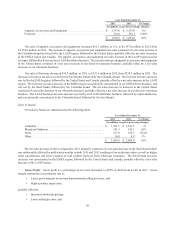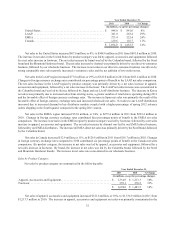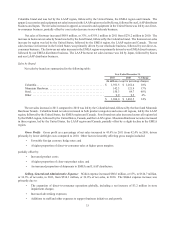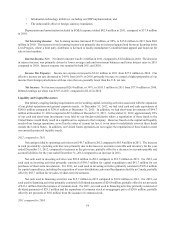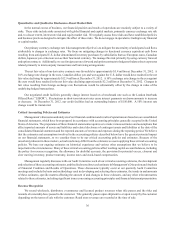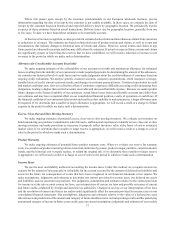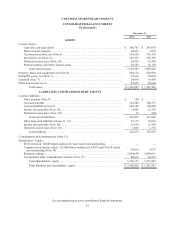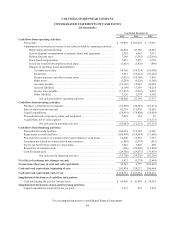Columbia Sportswear 2012 Annual Report Download - page 40
Download and view the complete annual report
Please find page 40 of the 2012 Columbia Sportswear annual report below. You can navigate through the pages in the report by either clicking on the pages listed below, or by using the keyword search tool below to find specific information within the annual report.36
Quantitative and Qualitative Disclosures About Market Risk
In the normal course of business, our financial position and results of operations are routinely subject to a variety of
risks. These risks include risks associated with global financial and capital markets, primarily currency exchange rate risk
and, to a lesser extent, interest rate risk and equity market risk. We regularly assess these risks and have established policies
and business practices designed to mitigate the effect of these risks. We do not engage in speculative trading in any financial
or capital market.
Our primary currency exchange rate risk management objective is to mitigate the uncertainty of anticipated cash flows
attributable to changes in exchange rates. We focus on mitigating changes in functional currency equivalent cash flows
resulting from anticipated U.S. dollar denominated inventory purchases by subsidiaries that use European euros, Canadian
dollars, Japanese yen or Korean won as their functional currency. We manage this risk primarily by using currency forward
and option contracts. Additionally, we use foreign currency forward and option contracts to hedge net balance sheet exposures
related primarily to intercompany transactions and borrowing arrangements.
The net fair value of our derivative contracts was favorable by approximately $5.4 million at December 31, 2012. A
10% exchange rate change in the euro, Canadian dollar, yen and won against the U.S. dollar would have resulted in the net
fair value declining by approximately $12.9 million at December 31, 2012. A 10% exchange rate change in the yen against
the euro would have resulted in the net fair value declining approximately $2.2 million at December 31, 2012. Changes in
fair value resulting from foreign exchange rate fluctuations would be substantially offset by the change in value of the
underlying hedged transactions.
Our negotiated credit facilities generally charge interest based on a benchmark rate such as the London Interbank
Offered Rate (“LIBOR”). Fluctuations in short-term interest rates cause interest payments on drawn amounts to increase
or decrease. At December 31, 2012, our credit facilities had an outstanding balance of $156,000. A 10% interest rate
change would be immaterial.
Critical Accounting Policies and Estimates
Management’s discussion and analysis of our financial condition and results of operations are based on our consolidated
financial statements, which have been prepared in accordance with accounting principles generally accepted in the United
States of America. The preparation of these financial statements requires us to make various estimates and assumptions that
affect reported amounts of assets and liabilities and related disclosure of contingent assets and liabilities at the date of the
consolidated financial statements and the reported amounts of revenue and expenses during the reporting period. We believe
that the estimates and assumptions involved in the accounting policies described below have the greatest potential impact
on our financial statements, so we consider these to be our critical accounting policies and estimates. Because of the
uncertainty inherent in these matters, actual results may differ from the estimates we use in applying these critical accounting
policies. We base our ongoing estimates on historical experience and various other assumptions that we believe to be
important in the circumstances. Many of these critical accounting policies affect working capital account balances, including
the policy for revenue recognition, the allowance for doubtful accounts, the provision for potential excess, closeout and
slow moving inventory, product warranty, income taxes and stock-based compensation.
Management regularly discusses with our Audit Committee each of our critical accounting estimates, the development
and selection of these accounting estimates, and the disclosure about each estimate in Management’s Discussion and Analysis
of Financial Condition and Results of Operations. These discussions typically occur at our quarterly Audit Committee
meetings and include the basis and methodology used in developing and selecting these estimates, the trends in and amounts
of these estimates, specific matters affecting the amount of and changes in these estimates, and any other relevant matters
related to these estimates, including significant issues concerning accounting principles and financial statement presentation.
Revenue Recognition
We record wholesale, distributor, e-commerce and licensed product revenues when title passes and the risks and
rewards of ownership have passed to the customer. Title generally passes upon shipment to or upon receipt by the customer
depending on the terms of sale with the customer. Retail store revenues are recorded at the time of sale.






